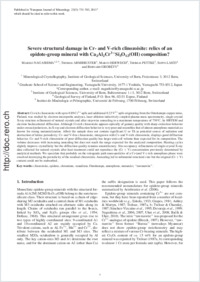Severe structural damage in Cr- and V-rich clinozoisite: relics of an epidote-group mineral with Ca₂ Al₂ Cr³⁺ Si₃ O₁₂ (OH) composition?
- Nagashima, Mariko Mineralogical Crystallography, Institute of Geological Sciences, University of Bern, Bern, Switzerland - Graduate School of Science and Engineering, Yamaguchi University, Japan
- Armbruster, Thomas Mineralogical Crystallography, Institute of Geological Sciences, University of Bern, Bern, Switzerland
- Herwegh, Marco Institute of Geological Sciences, University of Bern, Switzerland
- Pettke, Thomas Institute of Geological Sciences, University of Bern, Switzerland
- Lahti, Seppo Geological Survey of Finland, Espoo, Finland
- Grobéty, Bernard University of Fribourg, Dep. of Geosciences and FRIMAT, Switzerland
-
2011
Published in:
- European Journal of Mineralogy. - 2011, vol. 23, no. 5, p. 731-743
English
Cr-rich clinozoisite with up to 0.89 Cr³ apfu and additional 0.23 V³⁺ apfu originating from the Outokumpu copper mine, Finland, was studied by electron microprobe analyses, laser ablation inductively coupled-plasma mass spectrometry, single-crystal X-ray structure refinement of natural crystals and after step-wise annealing to a maximum temperature of 750°C, by HRTEM and electron backscattered diffraction. Although Cr-rich clinozoisite appears optically of gemmy quality with sharp extinction behavior under crossed polarizers, its X-ray and electron-diffraction behavior is very poor and resembles that of almost amorphous materials as known for strong metamictization. Albeit the sample does not contain significant U or Th as potential source of radiation and destruction of lattice periodicity. Cr- and V-free clinozoisite, intergrown with Cr- and V-rich clinozoisite, displays good diffraction behavior. Cr- and V-rich clinozoisite of poor diffraction quality has larger unit-cell volume than expected for its composition. The volume decreases with increasing annealing but does not reach the range expected for the analyzed composition. Heating cycles slightly improve crystallinity but the diffraction quality remains unsatisfactory. Site occupancy refinements of single-crystal X-ray data collected for natural crystals after heat treatment could not reproduce the (Cr + V) concentration previously determined by analytical methods. We speculate that probably on the retrograde path nano-particles of a Cr-(and V-) rich amorphous phase were exsolved destroying the periodicity of the residual clinozoisite. Annealing led to substantial structural cure but the original (Cr + V) content could not be reabsorbed.
- Faculty
- Faculté des sciences et de médecine
- Department
- Département de Géosciences
- Language
-
- English
- Classification
- Mineralogy
- License
- License undefined
- Identifiers
-
- RERO DOC 28715
- DOI 10.1127/0935-1221/2011/0023-2153
- Persistent URL
- https://folia.unifr.ch/unifr/documents/302344
Statistics
Document views: 86
File downloads:
- gro_ssd.pdf: 124
